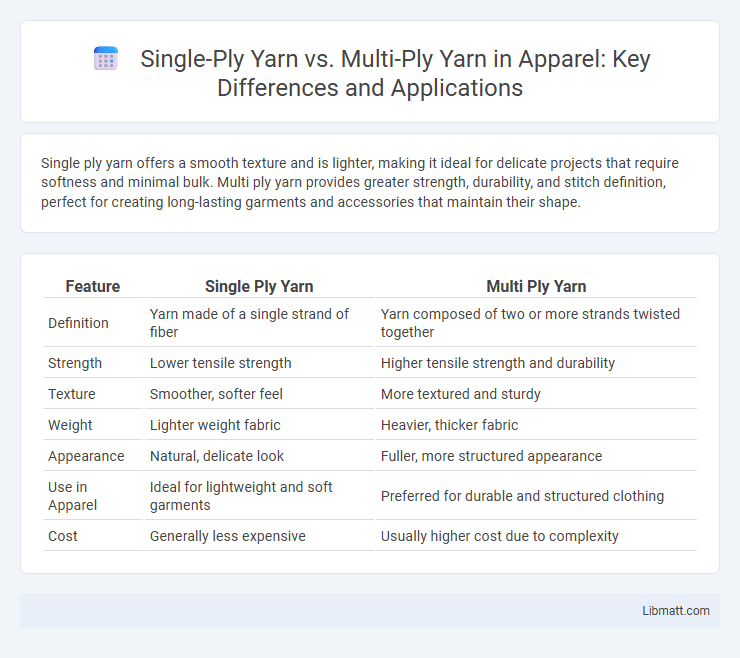Single ply yarn offers a smooth texture and is lighter, making it ideal for delicate projects that require softness and minimal bulk. Multi ply yarn provides greater strength, durability, and stitch definition, perfect for creating long-lasting garments and accessories that maintain their shape.
Table of Comparison
| Feature | Single Ply Yarn | Multi Ply Yarn |
|---|---|---|
| Definition | Yarn made of a single strand of fiber | Yarn composed of two or more strands twisted together |
| Strength | Lower tensile strength | Higher tensile strength and durability |
| Texture | Smoother, softer feel | More textured and sturdy |
| Weight | Lighter weight fabric | Heavier, thicker fabric |
| Appearance | Natural, delicate look | Fuller, more structured appearance |
| Use in Apparel | Ideal for lightweight and soft garments | Preferred for durable and structured clothing |
| Cost | Generally less expensive | Usually higher cost due to complexity |
Introduction to Single Ply and Multi Ply Yarn
Single ply yarn consists of fibers twisted together into a single strand, offering a smooth texture and lightweight feel ideal for delicate or fine fabric applications. Multi ply yarn is created by twisting two or more single ply yarns together, enhancing strength, durability, and resistance to pilling, making it suitable for heavier textiles and knitwear. The choice between single ply and multi ply yarn impacts the fabric's texture, strength, and overall performance in textile manufacturing.
Defining Characteristics of Single Ply Yarn
Single ply yarn consists of a single strand of fibers twisted together, resulting in a smooth, uniform texture with minimal fuzz. Its simplicity offers a soft hand feel and subtle sheen, making it ideal for lightweight garments and delicate knitting projects. Single ply yarns tend to have less elasticity and strength compared to multi ply yarns, impacting durability in high-stress applications.
Key Features of Multi Ply Yarn
Multi ply yarn consists of two or more single yarns twisted together, enhancing strength, durability, and uniformity compared to single ply yarn. This construction provides better resistance to abrasion and pilling, making multi ply yarn ideal for heavy-duty textiles and high-performance fabrics. Its increased thickness and stability ensure improved dimensional stability and longevity in finished products.
Strength and Durability Comparison
Single ply yarn offers a smoother texture but generally has lower strength and durability compared to multi ply yarn, which is composed of several strands twisted together for enhanced toughness. Multi ply yarn resists wear and tear better, making it ideal for heavy-duty applications and garments requiring long-lasting performance. Choosing multi ply yarn for your projects ensures improved tensile strength and resilience, extending the lifespan of the fabric.
Texture and Appearance Differences
Single ply yarn features a smoother texture and a more delicate appearance due to its single strand construction, making it ideal for lightweight and fine fabrics. Multi ply yarn combines multiple strands twisted together, resulting in a stronger, more durable texture with increased thickness and a slightly coarse appearance, enhancing fabric resilience. The choice between single ply and multi ply yarn directly impacts the final textile's softness, strength, and visual richness.
Performance in Knitting and Crocheting
Single ply yarn offers a soft, smooth texture with excellent stitch definition, making it ideal for detailed knitting and crocheting projects. Multi ply yarn provides greater strength, durability, and even tension, ensuring your finished garments withstand wear and maintain shape over time. Your choice between single and multi ply yarn will impact both the appearance and longevity of your handcrafted items.
Best Uses for Single Ply Yarn
Single ply yarn is ideal for lightweight sweaters, shawls, and accessories due to its soft texture and smooth appearance. Its single strand construction allows for excellent stitch definition and a delicate drape, making it perfect for intricate lace patterns and fine knitting projects. When you want a yarn that highlights detailed stitches while maintaining a light, airy feel, single ply yarn is a superior choice.
Ideal Applications for Multi Ply Yarn
Multi ply yarn is ideal for applications requiring enhanced durability and strength, such as upholstery, heavy-duty garments, and industrial textiles. The multiple strands twisted together provide superior resistance to wear and tear, making it suitable for products exposed to frequent abrasion. Its balanced texture also supports detailed weaving and knitting, improving fabric stability in high-stress uses.
Cost and Availability Factors
Single ply yarn typically costs less than multi ply yarn due to simpler manufacturing processes and lower material usage, making it a budget-friendly choice for many textile applications. Multi ply yarn, composed of multiple strands twisted together, generally commands a higher price due to increased durability and strength, which can justify the investment in premium or heavy-duty fabrics. Availability of single ply yarn is widespread and consistent across most markets, while multi ply yarn may have limited availability depending on specific fiber types and quality required by high-end or specialized textile producers.
How to Choose Between Single Ply and Multi Ply Yarn
Choosing between single ply and multi ply yarn depends on the desired strength, texture, and durability of your project. Single ply yarn offers a softer, more delicate feel ideal for lightweight garments, while multi ply yarn provides enhanced strength and resistance to pilling, making it suitable for durable items like sweaters and accessories. Assess the fiber content, stitch definition, and end-use of the knitted or crocheted piece to determine which yarn structure best meets your crafting needs.
Single Ply Yarn vs Multi Ply Yarn Infographic

 libmatt.com
libmatt.com